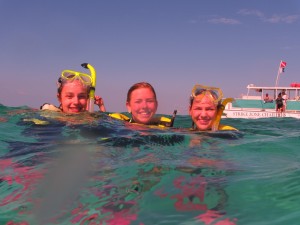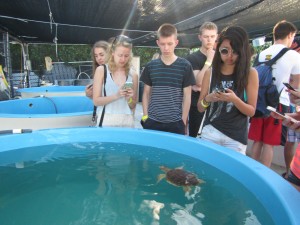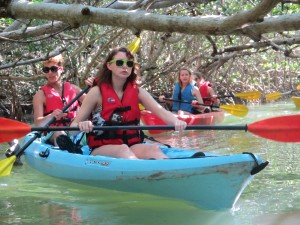Marine Biology: up close and personal
 The tropical marine environment is one of the richest and most wondrous natural habitats on Earth. The grade 11 Marine Biology trip is an exceptional learning opportunity to experience the biodiversity of the soft-coral reefs, mangrove forests and sea-grass beds that are found along the coast of the Florida Keys. This trip is an extension of the learning that occurs in the grade 11 biology, environmental science and geography courses.
The tropical marine environment is one of the richest and most wondrous natural habitats on Earth. The grade 11 Marine Biology trip is an exceptional learning opportunity to experience the biodiversity of the soft-coral reefs, mangrove forests and sea-grass beds that are found along the coast of the Florida Keys. This trip is an extension of the learning that occurs in the grade 11 biology, environmental science and geography courses.
This year, students explored a variety of shallow coastal marine habitats with masks and snorkel and kayaks. The first habitat explored was the mangrove forests in which many fish, sea turtles, lobsters and a manatee were observed by snorkel and by kayak.
The second marine habitat was the soft-coral reefs that are found in the Florida Keys National Marine Sanctuary. The Sanctuary protects the third largest barrier reef in the world. We welcomed the expertise of the Keys Marine Lab, which is a marine laboratory facility used by universities across North America. Their knowledgeable staff took our students out on a chartered boat to a local reef known as Coffin’s Patch.
Here, the students got their first look at a typical coral reef. Hundreds of tropical fish, nurse sharks and a moray eel were observed here. After the dive, the students were given a tour of the lab and explored the Keys Marine Lab’s touch tank where we were able to hold various invertebrates found in tidal pools around Florida.
Our second dive took us to Looe Key, a much larger reef and home to larger marine life, such as goliath groupers and reef sharks.
 We also visited the Turtle Hospital in Marathon. This is a full veterinary hospital that is specifically designed for sea turtles. Here, students learned about the species of sea turtles found in Florida and the many activities that are threatening their habitat and the positive efforts being done to help.
We also visited the Turtle Hospital in Marathon. This is a full veterinary hospital that is specifically designed for sea turtles. Here, students learned about the species of sea turtles found in Florida and the many activities that are threatening their habitat and the positive efforts being done to help.
Another feature of the trip was the communal aspect to learning and living. Students had to cook and clean-up their own meals and lead mini-lessons on a specific topics of the flora and fauna in the Florida Keys.
The main goals of this trip were to observe the diversity of life in tropical marine environments, be exposed to the protection efforts in coral reef communities and develop a capacity and commitment to “speak up” in support of endangered habitats around the world. In between sessions, students fit-in some time to relax on the beach, watch beautiful sunsets and explore the historic town of Key West!


